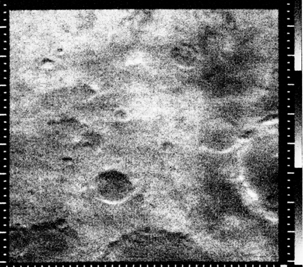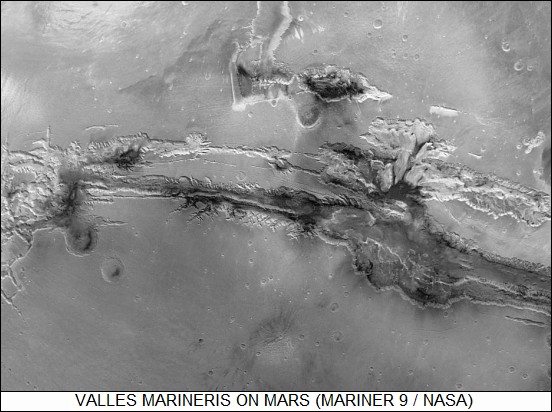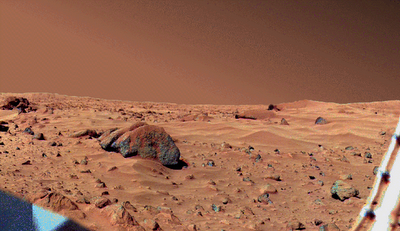Mars has always been less a mystery to astronomers than Venus. Through Earth-based telescopes the surface of the planet can easily be seen showing seasonal colour changes and from time to time a shrouded look from dust temporarily suspended in the atmosphere because of storms. In the 19th century astronomers fancied that they could see canals on Mars. Percival Lowell, the 20th century discoverer of Pluto, was convinced that the lines represented canals and a Martian civilization. So going to Mars would answer many questions.
Going to Mars Never Turned into a Space Race
Although the Soviet Union included Mars as a primary mission goal in its exploration of the inner planets of the Solar System, it enjoyed far greater success in getting to Venus, and very little success when trying for Mars. Why was that?
Engineers state that getting to Venus is easier than going to Mars. Venus is closer, easier to approach, requires less on board fuel for boosting the spacecraft further from the Sun as well as for mid-course corrections. Launch windows for Mars open every two years. Launch windows to Venus are far more frequent and longer in duration. Mars missions are significantly more expensive to mount because of the greater distance. With more financial resources to apply to space exploration than the Soviets the United States has reaped the benefit and become the prime explorer of Mars, not that the Soviets haven’t tried. But after four unsuccessful attempts in the 1960s they ceded Mars to the Americans.
The Technology of the 1960s that Got us to Mars
With Mariner-4 in July 1965 we witnessed the first close range images of Mars as the American spacecraft passed within 10,000 kilometers (6,200 miles) of the Martian surface. To get Mariner aloft the Americans used the Atlas Agena-D multi-stage rocket, the workhorse of the early 1960s unmanned and manned space program. Like their Soviet counterparts the Americans realized a direct path to Mars was best managed by first putting the spacecraft into Earth orbit before injecting it into a rendezvous trajectory aimed at Mars.
This first Martian explorer used four solar panels containing over 28,000 cells to keep its instrumentation operating throughout the seven month journey to the planet. The frame was magnesium to which the solar panels, antennae, TV camera, mid course propulsion system, and attitude control nitrogen gas jets, three gyros and regulators were attached. The science package included a magnetometer, dust detector, cosmic ray telescope, trapped radiation detector, solar plasma probe, and ionization chamber. Navigation positioning used sensors that located the Sun, Earth and Mars’ positions and the star Canopus. The telecommunications equipment included high and low gain antennas and a tape recording system for delayed transmission. The software command subsystem recognized 29 direct command words or 3 quantitative word commands. To keep the instrumentation from freezing or boiling the American engineers built into the spacecraft frame a series of adjustable louvers for climate control, insulating blankets to ward off the cold, and polished aluminum shields to keep the Sun-exposed side of the spacecraft cool.

The first images from Mariner-4 (see above) showed 1% of the planet’s surface, a heavily cratered area that gave us a picture of Moon-like desolation. Mars surface atmospheric pressure readings were 4.1 to 7.0 millibars (compare that to an average of 1,000 millibars at sea level on Earth) and daytime temperatures of -100 degrees Celsius (-148 Fahrenheit). No magnetic field was detected.
Even after completing its Martian flyby Mariner continued to transmit until December 1967. The cause of its demise was recorded by the on board cosmic dust detector, a micro-meteoroid shower that damaged the thermal shield, attitude control and data transmission.
Revisits to Mars by two Mariner spacecraft in 1969 enhanced our picture of Mars as they flew over the equator and south polar regions of the planet and provided further analysis of the Martian atmosphere and surface conditions. The images captured by Mariners’ on board cameras continued to reveal a cratered landscape but atmospheric telemetry revealed suspended dust, CO2, H2O, CO, and ionized hydrogen and oxygen. Equatorial surface temperatures reached a benign 17 degrees Celsius (63 Fahrenheit) in the daytime.
Mariner-9 Becomes the First Artificial Martian Satellite
Mariner-4 demonstrated successful technology design for Martian missions and became the template for subsequent flights to Mars and planets further out. One of these was Mariner-9, one of two space missions planned to orbit Mars.The first, Mariner-8, experienced a launch failure. NASA quickly redesigned the Mariner-9 mission to compensate for the loss.
Unlike other interplanetary and lunar missions Mariner-9 followed a direct ascent trajectory from Earth to Mars arriving after a 167-day flight. This method was chosen to preserve fuel.
Orbital insertion involved firing of on board rockets several times to create ideal positioning for imaging and data transmissions to Earth. This technological feat was the first of its kind. No earth-launched spacecraft had ever orbited another planet.

When Mariner-9 arrived in September 1971 a planetary-wide dust storm made it impossible to obtain images of the surface. All that could be seen were the summits of four large volcanoes never observed before. These were Olympus Mons and the three Tharsis peaks. By December the storm abated and Mariner started sending images and relaying telemetry. During its 13-month mission Mariner sent 7,329 images covering the entire planet until running out of fuel. It remains in Martian orbit today and its orbit will degrade sometime around 2022.
Mariner-9 gave us an entirely new perspective about Mars. Its images showed ancient river beds and many other flow features indicating a past that included free-flowing water on the surface. Valles Marineris as seen in the picture above proved to be a canyon larger than anything on Earth. Mariner-9 took pictures of wind-eroded sediments and witnessed weather system changes including morning fog. No longer was Mars seen as Moon-like.
The Soviets Duplicate the Feat of Mariner-9
In 1971 the Soviet Union launched an even more ambitious attempt to both orbit the planet and land upon it. They launched two orbiters, Mars-2 and Mars-3, each including a lander for studying and observing the Martian surface . Entering orbit in November Mars-2 included an on board camera and a scientific instrument payload. The Mars-2 lander, crashed in attempting a controlled descent. The Mars-3 lander achieved a soft landing and within a minute fell silent. The global dust storm enveloping Mars at the time was believed to be the cause of failure.
The Soviets continued to launch a Mars series of robotic spacecraft through 1972 and 1973 experiencing more failures than successes. Their technology for Martian landings did not work. Chip degradation during the long spaceflight was believed to have been one of the causes of failure with both the orbiters and landers. After 1973 the Soviet program stopped.
The Vikings Land on Mars
In the Bicentennial year of 1976 the United States accomplished two successful landings on the Martian surface. Viking-1 and Viking-2 were a combination of orbiters and landers. The Americans may have learned from the Soviet attempts at soft landings. The Soviets released their landers before their Mars spacecraft entered orbit. Every landing attempt either failed to touchdown properly or stopped transmitting shortly after arrival. The American answer was simple. Bring the entire spacecraft into an orbit around the planet. Have the orbiter photograph potential landing sites and then program the lander to make the descent to a site deemed safe.
Both Viking spacecraft, orbiters and landers were successfully deployed. Unlike previous Mars missions Vikings used Titan-IIIE-Centaur heavy-launchers to boost them into earth orbit before the Centaur stage placed them into an Earth to Mars trajectory. Both orbiters based their design on the Mariner-9 spacecraft but were much heavier, weighing 3,530 kilograms (7,766 pounds). The orbiters, in addition to performing reconnaissance on site selection for the landers, also acted as communications relays to transmit data from the landers back to Earth.
Both landers were timed to arrive on the planet surface in celebration of the July 1976 bicentennial and both achieved successful landing using heat shield technology, aerobraking, first practiced on Venus missions, parachute deployment followed by retrorocket fire to achieve controlled touch downs.

There remains controversy over findings from the landers’ scientific experiments. The experiments were specifically designed to study the biology and organic and inorganic chemical composition of Martian soil samples. A sampler arm with shovel scooped up a small amount of soil and placed it in an environmentally-controlled compartment where it was subject to three experiments. One of those, the Labelled Release experiment, designed by Dr. Gilbert Levin, obtained results that strongly suggested microbial metabolism. But another experiment designed to detect organic molecules found none. At the time it was assumed that a previously unknown chemical in the Martian soil was mimicking microbial metabolism. At the time of NASA’s announcement of experimental results it was not disclosed that on Earth in similar tests in Antarctica Dr. Levin’s experiment showed microbial metabolism while the organic molecule detection experiment found nothing. The controversy over Levin’s experiment continues to this day with a number of journal articles suggesting that there was and is no support for chemical agents being the cause of the observed response on Mars. More recently Martian orbiters, landers and rovers have uncovered evidence that water in liquid form exists on Mars and that Dr. Levin’s conclusions that rudimentary microbial life exists may have been right after all.
We will continue exploring Mars in our next space blog. So please stay tuned and join the conversation giving your opinion on whether life still exists on Mars today.














